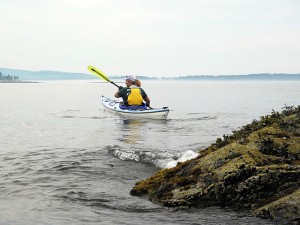
A middle-aged woman is relaxing in her kayak in a part of a lake that is only three feet deep. She closes her eyes and leans back, soaking in the summer sunlight. The fish aren’t biting and the day is hot. She unbuckles her PFD (personal flotation device), removes it, and then a minute later, slips off the kayak and into the lake. She has just broken a state law.
A Greenland rolling enthusiast who can perform more than 30 different types of Eskimo rolls has been traveling throughout the U.S., putting on rolling demonstrations. He uses a narrow wooden paddle, sits in a skin-on-frame kayak, and wears a tuilik, a traditional garment that serves as both spray deck and paddling jacket — and also provides flotation. He has traveled to Maine to demonstrate his skills in Rockland Harbor. Even though he will never be more than 20 feet from onlookers and the dock, even though the tuilik provides plenty of flotation, and even though wearing a PFD will actually reduce the flexibility of the tuilik and impair his freedom of movement, he is told he must wear a U.S. Coast Guard approved PFD or he will be in violation of Maine law.
Three 20-something friends have gotten together for an summer afternoon at the pond. All three are previous competitive swimmers with WSI training. It is a hot day and they decide to race to the boat landing on the opposite shore, each using his preferred mode of travel. The first is given a head start and sets off swimming, wearing nothing but his speedo. The second stashes his PFD under his seat of his rowboat and sets off three minutes later. The third puts his PFD behind the seat of his kayak and sets off paddling one minute after that. The kayaker arrives first, winning the impromptu half-mile race, but the distinction he will remember is that, of the three, he is the only one to be fined for violation of Maine law.
The three scenarios above are aimed to point out some of the problems in logic that are inherent in the recently proposed bill that would require all Maine kayakers and canoeists to wear life jackets.
Don’t get me wrong. I am not anti-life jacket. I wear a life jacket more than 99% of the time when paddling and routinely ask friends and guests to do the same. The questions, for me, are whether Maine needs to put a law on the books to tell us what we already know, whether increased education might be better than increased legislation, whether enforcement of this law will be a headache for Maine wardens, and whether the law will do any good.
I do see both sides of the issue. On one side is the argument that current law already requires paddlers to have a life jacket on board and in an accessible place. In a kayak, especially, securely stowing a life jacket on board is often more inconvenient than wearing it.
Anyone who has tried to pull on and fasten a PFD while in the water has an additional reason to believe that meeting the requirements of current law by stowing a life jacket on board is not a very practical, should you end up actually needing that life jacket.
Wearing a PFD is something you do for others, if not for yourself. Wearing it increases your chance of survival if you do capsize. If you need to be rescued, it increases the chances that you will be still alive when rescuers reach you. If you capsize and don’t survive, it shortens the amount of time that rescuers will spend looking for you. Search and rescue operations are expensive and sometimes dangerous — and, if they go on for days, all the more so.
That said, I am not fond of legislation that interferes with what should be a personal decision. Pass legislation mandating the wearing of PFDs, and you wouldn’t have to go far down the slippery slope to see laws requiring helmets for motorcyclists, bicyclists and skiers, personal locator beacons for back-country hikers, survival suits for winter boaters and ice fishermen . . . and the list could go on and on.
Some have suggested that by focusing narrowly on kayakers and canoeists, the law creates a double-standard and creates the impression that kayaks and canoes are inherently less safe than other types of watercraft. It seems important to state that in the right hands and in the right conditions, kayaks and canoes are very safe. It is the user — not the craft — that determines safety.
One concern about the proposed new law is that it is reactionary, resulting from a single constituent’s request to a legislator, which in turn followed a summer in which several paddlers died in Maine waters. Beyond that, the bill seems hastily put together and lacks in logic. Part of that lack in logic is the enforcement end of it. By all means, yes, put up signs at boat launches reminding paddlers to wear their life jackets. But don’t use taxpayer money to chase offenders. Don’t clog our courts prosecuting those who refuse to pay. Maine wardens are stretched thin as it is; the PFD-less paddler is not endangering anyone but himself. A warden’s time is better spent promoting safety, providing education, and protecting resources.
As the scenarios I opened with above illustrate, when it comes to life jackets, one size does not fit all. The vast majority of paddlers really ought to wear their life jackets the vast majority of the time, but there are exceptions. Wearing a life jacket should be an individual decision. At a time in which deregulation of everything from schools to businesses is so much the fashion, it is ironic that there is talk of attaching additional regulations to the simple act of slipping out onto a pond for a morning paddle.
Resources:
http://bangordailynews.com/2011/10/23/politics/bill-to-require-life-jackets-for-paddle-boaters-may-not-hit-legislature-until-2013/
http://bangordailynews.com/2011/09/14/politics/bill-would-require-paddlers-to-wear-life-jackets/
http://www.boaterexam.com/usa/maine/pfd.aspx